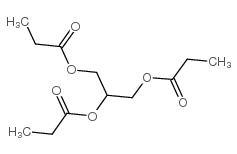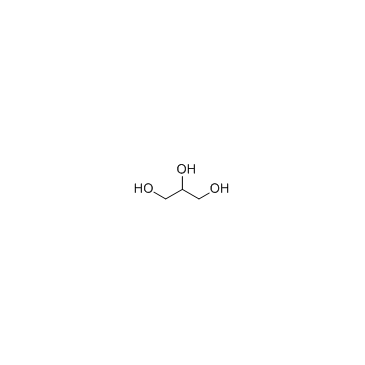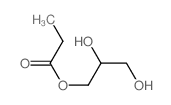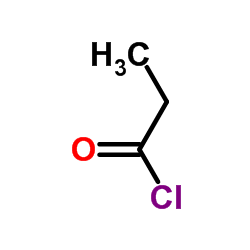Tripropionin

Tripropionin structure
|
Common Name | Tripropionin | ||
|---|---|---|---|---|
| CAS Number | 139-45-7 | Molecular Weight | 260.28400 | |
| Density | 1.082 | Boiling Point | 175-176 °C20 mm Hg(lit.) | |
| Molecular Formula | C12H20O6 | Melting Point | N/A | |
| MSDS | Chinese USA | Flash Point | >230 °F | |
| Name | Glycerol Tripropionate |
|---|---|
| Synonym | More Synonyms |
| Density | 1.082 |
|---|---|
| Boiling Point | 175-176 °C20 mm Hg(lit.) |
| Molecular Formula | C12H20O6 |
| Molecular Weight | 260.28400 |
| Flash Point | >230 °F |
| Exact Mass | 260.12600 |
| PSA | 78.90000 |
| LogP | 1.21460 |
| Vapour density | 8.95 (vs air) |
| Vapour Pressure | 0.00204mmHg at 25°C |
| Index of Refraction | n20/D 1.434(lit.) |
CHEMICAL IDENTIFICATION
HEALTH HAZARD DATAACUTE TOXICITY DATA
|
| Personal Protective Equipment | Eyeshields;Gloves |
|---|---|
| Hazard Codes | F,Xn,N |
| Risk Phrases | R11:Highly Flammable. R20/22:Harmful by inhalation and if swallowed . R36/37/38:Irritating to eyes, respiratory system and skin . R51/53:Toxic to aquatic organisms, may cause long-term adverse effects in the aquatic environment . |
| Safety Phrases | 24/25 |
| RIDADR | UN 2048 3/PG 3 |
| WGK Germany | 2 |
| RTECS | YK6000000 |
| Packaging Group | III |
| Hazard Class | 3 |
| HS Code | 29021990 |
|
~97% 
Tripropionin CAS#:139-45-7
Detail
|
| Literature: Novus International Inc. Patent: US2007/292485 A1, 2007 ; Location in patent: Page/Page column 15 ; |
|
~94% 
Tripropionin CAS#:139-45-7 |
| Literature: Prager, Rolf H.; Yurui, Zhang Australian Journal of Chemistry, 1989 , vol. 42, # 6 p. 1003 - 1005 |
|
~% 
Tripropionin CAS#:139-45-7 |
| Literature: Biochimica et Biophysica Acta, , vol. 8, p. 407,409 |
|
~% 
Tripropionin CAS#:139-45-7 |
| Literature: Zeitschrift fuer Biologie (Munich), vol. 61, p. 551 |
| HS Code | 2915900090 |
|---|---|
| Summary | 2915900090 other saturated acyclic monocarboxylic acids and their anhydrides, halides, peroxides and peroxyacids; their halogenated, sulphonated, nitrated or nitrosated derivatives VAT:17.0% Tax rebate rate:9.0% Supervision conditions:AB(certificate of inspection for goods inward,certificate of inspection for goods outward) MFN tariff:5.5% General tariff:30.0% |
|
Understanding the Mechanism of Enzyme-Induced Formation of Lyotropic Liquid Crystalline Nanoparticles.
Langmuir 31 , 6933-41, (2015) Liquid crystalline nanoparticles have shown great potential for application in fields of drug delivery and agriculture. However, optimized approaches to generating these dispersions have long been sou... |
|
|
Biochemical Characterization and Molecular Modeling of Pancreatic Lipase from a Cartilaginous Fish, the Common Stingray (Dasyatis pastinaca).
Appl. Biochem. Biotechnol. 176 , 151-69, (2015) In order to identify fish enzymes displaying novel biochemical properties, we have chosen the common stingray (Dasyatis pastinaca), one of the most primitive living jawed aquatic vertebrates as a star... |
|
|
Enzymatic hydrolysis of organic-core microcapsules to produce aqueous-core microcapsules.
J. Microencapsul. 25(3) , 179-86, (2008) This paper describes the development of a new method to obtain aqueous-core microcapsules from organic-core capsules. The direct production of microcapsules, using tripropionin as organic material, fo... |
| EINECS 205-365-1 |
| Tripropionin |
| Glyceryl tripropionate |
| 2,3-di(propanoyloxy)propyl propanoate |
| MFCD00027005 |





